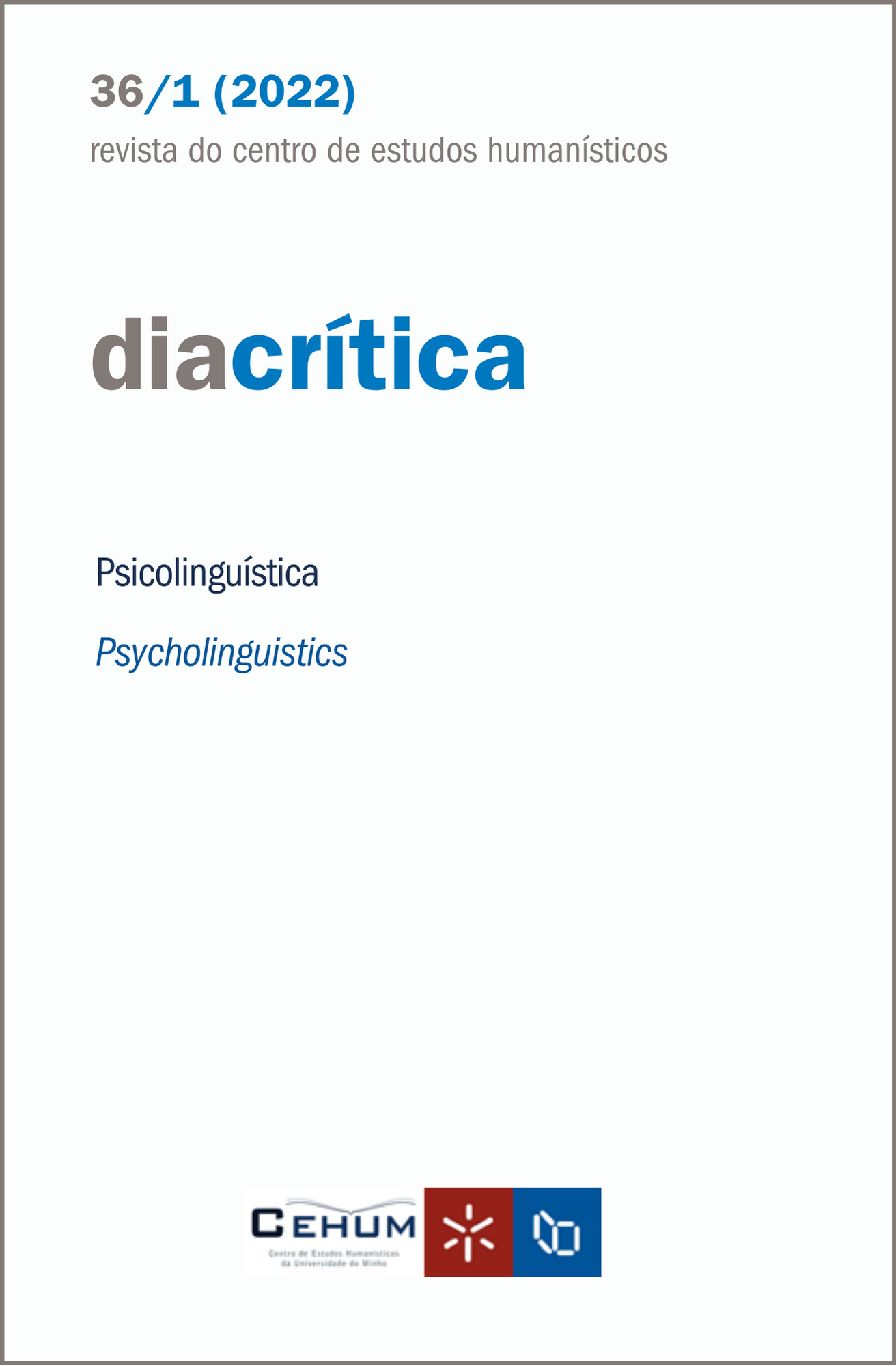Differences between stereotypical gender and definitional gender in pronominal antecedent retrieval in Brazilian Portuguese
DOI:
https://doi.org/10.21814/diacritica.4693Palavras-chave:
Resolução pronominal, Pistas de gênero, Recuperação na memória, Português brasileiroResumo
Together with Alves (2019), this paper is part of a research work dedicated to investigating the role of gender cues in pronominal antecedent retrieval in Brazilian Portuguese. The main aim is to determine whether Principle B structural constraints work as an initial filter in pronominal antecedent retrieval in Brazilian Portuguese, or whether gender cues play a major role at early processing phases since this language has visible redundant morphological markings. It is also examined whether antecedent candidates carrying different gender cues have different weights in memory. In the present work, a comparison between antecedent candidates carrying stereotypical gender and definitional gender was provided. The results of two eye-tracking experiments conducted with native speakers of Brazilian Portuguese showed that gender morphological cues play a role at the very beginning of pronoun resolution processing, and only at a later processing phase, structural constraints of Principle B seemed to help the parser to select the correct antecedent. Like the previous work, the results indicated Principle B structural constraints do not work as an initial filter blocking structurally unacceptable candidates in Brazilian Portuguese; on the contrary, all candidates seemed to be taken into account despite of violating Principle B structural constraints. Similarly to the previous work, masculine antecedent candidates were preferable to be retrieved by memory in comparison to feminine candidates. Moreover, the results indicated that candidates with definitional gender rather than stereotypical gender are preferable to be retrieved by memory since the former is lexically specified, while the latter relies on probabilities based on world knowledge inferences.
Referências
Alves, M. C. dos S. (2014). Processamento do traço de gênero na correferência pronominal com antecedentes sobrecomuns e comuns de dois gêneros no português do Brasil (Dissertação de mestrado, UFRJ, Rio de Janeiro). DOI: https://doi.org/10.5007/1984-8420.2014v15n2p72
Alves, M. C. dos S. (2019). As diferenças entre gênero gramatical e gênero semântico na recuperação de antecedentes pronominais em Português Brasileiro. Diacrítica, 33(2), 89–115. https://doi.org/10.21814/diacritica.403 DOI: https://doi.org/10.21814/diacritica.403
Arnold, J., Eisenband, J., Brown-Schmidt, S., & Trueswell, J. (2000). The rapid use of gender information: evidence of the time course of pronoun resolution from eyetracking. Cognition, 76(1), 13–26. https://doi.org/10.1016/s0010-0277(00)00073-1 DOI: https://doi.org/10.1016/S0010-0277(00)00073-1
Badecker, W. & Straub, K. (2002). The processing role of structural constraints on the interpretation of pronouns and anaphora. Journal of Experimental Psychology Learning Memory and Cognition, 28, 748–769. https://doi.org/10.1037/0278-7393.28.4.748 DOI: https://doi.org/10.1037/0278-7393.28.4.748
Cacciari, C., & Padovani, R. (2007). Further evidence of gender stereotype priming in Language: Semantic facilitation and inhibition in Italian role nouns. Applied Psycholinguistics, 28, 277–293. https://doi.org/10.1017/S0142716407070142 DOI: https://doi.org/10.1017/S0142716407070142
Canal, P., Garnham, A., & Oakhill, J. (2015). Beyond gender stereotypes in language comprehension: self sex-role descriptions affect the brain’s potentials associated with agreement processing. Frontiers in Psychology, 6. https://doi.org/10.3389/fpsyg.2015.01953 DOI: https://doi.org/10.3389/fpsyg.2015.01953
Carreiras, M., Garnham, A., Oakhill, J., & Cain, K. (1996). The use of stereotypical gender information in constructing a mental model: evidence from English and Spanish. The Quarterly Journal of Experimental Psychology, 49A(3), 639–663. https://doi.org/10.1080/713755647 DOI: https://doi.org/10.1080/027249896392531
Casado, A., Palma, A., & Paolieri, D. (2017). The influence of sex information on gender word processing. Journal of Psycholinguistic Research, 47(3), 1–27. https://doi.org/10.1007/s10936-017-9546-3
Chomsky, N. (1993). A minimalist program for linguistic theory. In K. Hale, S. J. Keyser (Eds.). The view from building 20 (pp. 1–52). Cambridge: The MIT Press. https://doi.org/10.1007/s10936-017-9546-3 DOI: https://doi.org/10.1007/s10936-017-9546-3
Chomsky, N. (1995) The Minimalist Program. Cambridge: The MIT Press.
Duff, S., & Keir, J. (2004). Violating stereotypes: Eye movements and comprehension
processes when text conflicts with world knowledge. Memory and Cognition, 32(4), 551–559. https://doi.org/10.3758/BF03195846 DOI: https://doi.org/10.3758/BF03195846
Engelmann, F., Jäger, L., & Vasishth, S. (2015). The determinants of retrieval interference in dependency resolution: Review and computational modeling. Unpublished manuscript.
Foraker, S., & McElree, B. (2007). The role of prominence in pronoun resolution: active versus passive representations. Journal of Memory and Language, 56(3), 357–383. https://psycnet.apa.org/doi/10.1016/j.jml.2006.07.004 DOI: https://doi.org/10.1016/j.jml.2006.07.004
Gordon, P., & Hendrick, R. (1998). The representation and processing of coreference in discourse. Cognitive Science, 22(4), 389–424. https://doi.org/10.1016/S0364-0213(99)80045-7 DOI: https://doi.org/10.1207/s15516709cog2204_1
Greene, S. B., McKoon, G., & Ratclif, R. (1992). Pronoun resolution and discourse models. Journal of Experimental Psychology: Learning, Memory and Cognition, 18(2), 266–283. https://doi.org/10.1037//0278-7393.18.2.266 DOI: https://doi.org/10.1037/0278-7393.18.2.266
Grosz, B., Weinstein, S., & Joshi, A. (1995). Centering: A framework for modeling the local coherence of discourse. Computational Linguistics, 21(2), 203–225. DOI: https://doi.org/10.21236/ADA324949
Kehler, A. (2007). Rethinking the SMASH approach to pronoun interpretation. In J. Gundel & N. Hedberg (Eds.), Interdisciplinary perspectives on reference processing (pp. 95–122). Oxford: Oxford University Press. https://doi.org/10.1093/acprof:oso/9780195331639.001.0001 DOI: https://doi.org/10.1093/acprof:oso/9780195331639.003.0005
Kneiner, H., Sturt, P., & Garrod, S. (2008). Processing definitional and stereotypical gender in reference resolution: Evidence from eye-movements. Journal of Memory and Language, 58(2), 239–261. https://doi.org/10.1016/j.jml.2007.09.003 DOI: https://doi.org/10.1016/j.jml.2007.09.003
Leitão, M., Peixoto, P., & Santos, S. (2008). Processamento da co-referência intra-sentencial em português brasileiro. Veredas, 12(2), 50–61.
Nicol, J., & Swinney, D.A. (1989). The role of structure in coreference assignment during sentence comprehension. Journal of Psycholinguists Research, 18(1), 5–19. https://doi.org/10.1007/BF01069043 DOI: https://doi.org/10.1007/BF01069043
Oakhill, J., Garnham, A., & Reynolds, D. (2005). Immediate activation of stereotypical gender information. Memory and Cognition, 33(6), 972–983. https://doi.org/10.3758/BF03193206 DOI: https://doi.org/10.3758/BF03193206
Osterhout, L., Bersick, M., & McLaughlin, J. (1997). Brain potentials reflect violations of gender stereotypes. Memory and Cognition, 25(3), 273–285. https://doi.org/10.3758/BF03211283 DOI: https://doi.org/10.3758/BF03211283
Patil, U., Vasishth, S., & Lewis, R. (2016). Retrieval interference in syntactic processing: The case of reflexive binding in English. Frontiers of Psychology, 7, 329. https://doi.org/10.3389/fpsyg.2016.00329 DOI: https://doi.org/10.3389/fpsyg.2016.00329
Rigalleau, F., Caplan, D, Baudiffier, V. (2004). New arguments in favor of an automatic gender pronominal process. The Quarterly Journal of Experimental Psychology Section A: Human Experimental Psychology, 57(5), 893–933. https://doi.org/10.1080/02724980343000549 DOI: https://doi.org/10.1080/02724980343000549
Sturt, P. (2003). The time-course of the application of binding constraints in reference. Journal of Memory and Language, 48(3), 542–562. https://doi.org/10.1016/S0749-596X(02)00536-3 DOI: https://doi.org/10.1016/S0749-596X(02)00536-3
Downloads
Publicado
Como Citar
Edição
Secção
Licença

Este trabalho encontra-se publicado com a Licença Internacional Creative Commons Atribuição 4.0.










